
|
|
FYBUSH.COM/SITE OF THE WEEK
NEEDS YOUR SUPPORT! (AND YOU CAN GET A FREE TOWER SITE CALENDAR
IF YOU PLEDGE NOW...) CLICK HERE
TO LEARN MORE...
February 19-25, 2004
A Visit to Ohio's Capital City
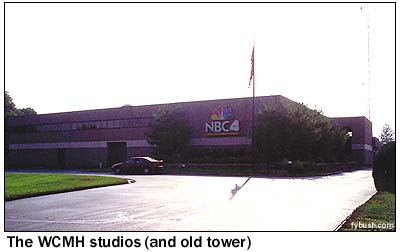 Quick
- what's the most populous city in Ohio? Cincinnati? Not even
close. Cleveland? Used to be. But thanks in no small part to
the miracle of annexation, the city of Columbus now numbers more
than 700,000 inhabitants - far and away the biggest city in the
Buckeye State.
Quick
- what's the most populous city in Ohio? Cincinnati? Not even
close. Cleveland? Used to be. But thanks in no small part to
the miracle of annexation, the city of Columbus now numbers more
than 700,000 inhabitants - far and away the biggest city in the
Buckeye State.
(It's not even that far off its cross-state rivals in market size - it's radio market 31 to Cincy's #26 and Cleveland's #25, and TV market #34 to Cincy's #32 and Cleveland's #15, helpfully augmented by Canton and Akron.)
And for the tower hunter and broadcast history buff, Columbus has much more to offer than just being a convenient stop where I-70 crosses I-71. We first explored its sites - and took most of the pictures you see here - on the way home from the National Radio Club convention in August 2000 in Lima, Ohio. (Unfortunately, it was a very bright sunny day, and the sun was almost always in just the wrong spot for many of these pictures, taken in the late afternoon. Sorry about that!)
Our tour began a little northwest of downtown, in the neighborhoods across the Olentangy River from Ohio State University. In addition to being the area's second-largest employer (only the state of Ohio has more local workers), OSU is a major broadcast force in town, and has been for many years.
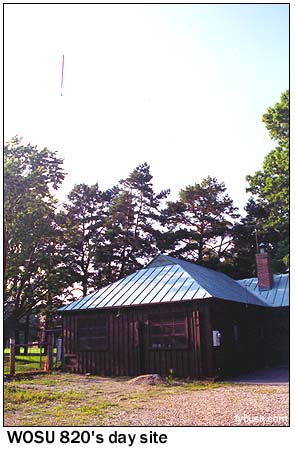
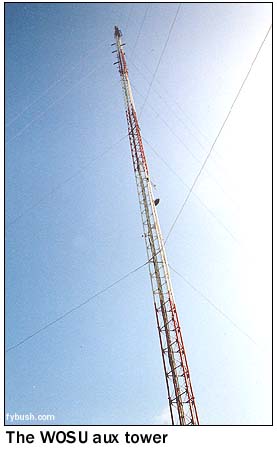 Before we get to
WOSU, though, we stop on Olentangy River Road for a peek at Columbus'
longtime NBC affiliate. What's now WCMH-TV 4 ("CMH"
is the city's airport code) started out in 1949 as WLWC, a part
of the AVCO/Crosley WLW TV network that was based at WLWT in
Cincinnati and also included WLWD in Dayton and WLWI in Indianapolis.
Back then, its studio on Olentangy River Road was also its transmitter
site, and it was on channel 3. (Cleveland's WNBK was then on
channel 4; the two would swap channels early in the fifties.)
Crosley even had an FM on the WLWC tower, WLWF (96.3), but as
with so many early FM stations, it didn't last.
Before we get to
WOSU, though, we stop on Olentangy River Road for a peek at Columbus'
longtime NBC affiliate. What's now WCMH-TV 4 ("CMH"
is the city's airport code) started out in 1949 as WLWC, a part
of the AVCO/Crosley WLW TV network that was based at WLWT in
Cincinnati and also included WLWD in Dayton and WLWI in Indianapolis.
Back then, its studio on Olentangy River Road was also its transmitter
site, and it was on channel 3. (Cleveland's WNBK was then on
channel 4; the two would swap channels early in the fifties.)
Crosley even had an FM on the WLWC tower, WLWF (96.3), but as
with so many early FM stations, it didn't last.
As you can see in the photo at the top of the page, the building has been heavily renovated since then, and the tower out back is now used for STLs and ENG but not for transmitting.
On to OSU, then: At left we see the first station to bear the WOSU calls, the facility on AM 820 that traces its history back to 1922. For most of that time, it was a daytimer (with authorization to remain on the air until sunset at the WBAP/WFAA 820 site in Grapevine, Texas, which bought it an extra hour or so past Columbus sundown), and its 5 kW day signal has been at this same spot - in the maintenance building on the OSU golf course off Tremont Road - for decades, though the tower just barely seen here was replaced by a newer one last year. (You can just make out the tower rising above the trees behind the transmitter building; that's an old antenna for WOSU-FM 89.7 at the top, I believe.)
And check out that picture below - it's a peek through the window at the wonderful old AM 820 transmitters. Take a close look at the one on the right - that's not an RCA "meatball" logo on the cabinet - it's a "WOSU" meatball!
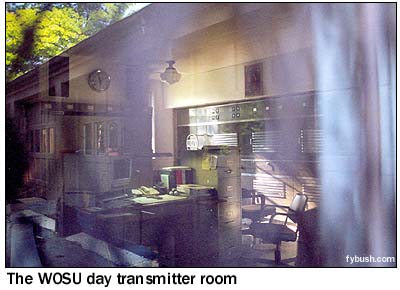
|
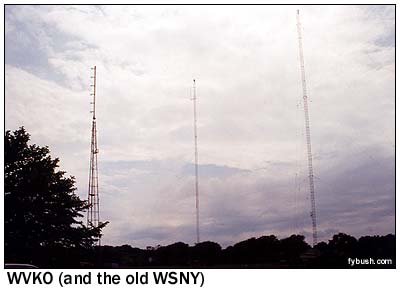
|
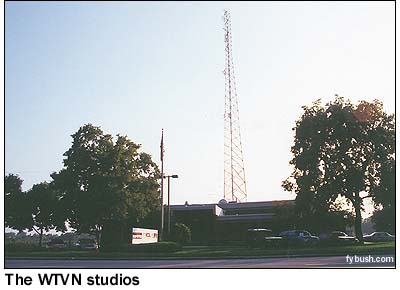 And
there's one more tower to note before we leave this neighborhood
- a half-mile east of the 820 site, not far from the WOSU studio
complex and the OSU stadium where all that big-time college football
is played, is the 430-foot tower shown above at right. At the
moment, it houses only an auxiliary antenna for WOSU-FM, an LPTV
and a 106.7 translator for WOSU, but when it was built in 1974
it was the primary site for both WOSU-FM and WTVN-TV (Channel
6), Columbus' ABC affiliate.
And
there's one more tower to note before we leave this neighborhood
- a half-mile east of the 820 site, not far from the WOSU studio
complex and the OSU stadium where all that big-time college football
is played, is the 430-foot tower shown above at right. At the
moment, it houses only an auxiliary antenna for WOSU-FM, an LPTV
and a 106.7 translator for WOSU, but when it was built in 1974
it was the primary site for both WOSU-FM and WTVN-TV (Channel
6), Columbus' ABC affiliate.
Channel 6 signed on in 1949 as the city's ABC/DuMont affiliate, operating from the WHKC (610) tower site south of the city in Obetz, which we'll see next week. The 1974 move eliminated some of the interference between channel 6 and the close-in-frequency 89.7 FM signal.
These days, the DuMont affiliation is long gone and channel 6 is WSYX, having left the WTVN callsign to its sister station on AM 610. When we visited in 2000, both stations had side-by-side studios on Dublin Road, along the Scioto River about a mile southwest of the old channel 6 tower.
WSYX is still there, sharing its studios with Sinclair LMA partner and Fox affiliate WTTE (Channel 28). The two stations share a common newscast ("News Center") that's a distant third to the offerings of WCMH and CBS affiliate WBNS-TV (Channel 10), and these days they share a common tower as well - but we'll get there in a minute.
WTVN is, even as we put this week's issue on the Web, moving out of its building next door (shared in 2000 with WCOL 92.3 and WFII 1230) into a new suburban facility that will be home to all of the market's Clear Channel stations.
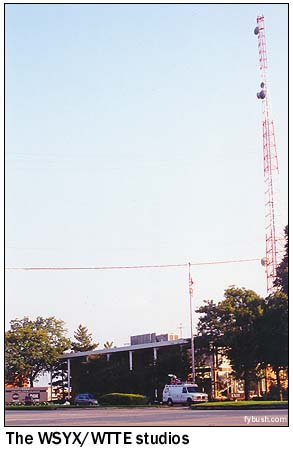
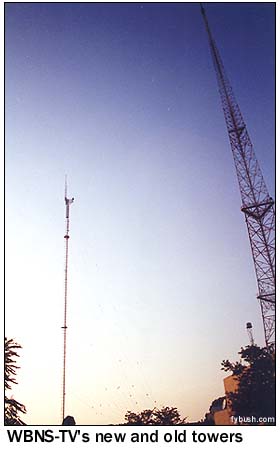 (Columbus was one
of the Ohio markets where Clear Channel's predecessor, Jacor,
was among the first big cluster-builders - the group here now
also includes top-40 giant WNCI 97.9 and three move-in FM signals,
WFJX 105.7 Hilliard, formerly of Marysville; WLZT 93.3 Ashville,
formerly in Chillicothe; and soon, WMRN-FM from Marion, which
will move to Dublin and move from 106.9 to 106.7.)
(Columbus was one
of the Ohio markets where Clear Channel's predecessor, Jacor,
was among the first big cluster-builders - the group here now
also includes top-40 giant WNCI 97.9 and three move-in FM signals,
WFJX 105.7 Hilliard, formerly of Marysville; WLZT 93.3 Ashville,
formerly in Chillicothe; and soon, WMRN-FM from Marion, which
will move to Dublin and move from 106.9 to 106.7.)
Also nearby is the studio/office facility of Paramount's WWHO (Channel 53), licensed to Chillicothe, about 40 miles to the south, but serving Columbus with UPN and WB programming. (It now identifies itself as "UPN Columbus," and surprised the heck out of us when it turned up on the antenna here at NERW Central during a DX opening last summer...but we digress.)
Follow Dublin Road east towards downtown Columbus, and right where the Scioto and Olentangy rivers meet is one of the more dramatic tower sites in town.
770 Twin Rivers Drive is where the studios for WBNS-TV (Channel 10) and its sister cable network, the Ohio News Network, are located - and with them, two tall towers.
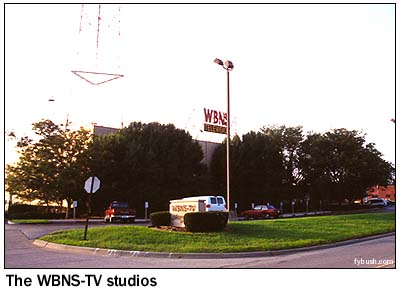 The
self-supporting tower, 839 feet tall, was built in 1956 for channel
10. (I suspect, but don't know for sure, that WBNS-TV was at
the WBNS 1460 tower site on Barnett Road until then - and just
wait until you see that site in next week's installment!)
The
self-supporting tower, 839 feet tall, was built in 1956 for channel
10. (I suspect, but don't know for sure, that WBNS-TV was at
the WBNS 1460 tower site on Barnett Road until then - and just
wait until you see that site in next week's installment!)
In 1981, it was joined by the 1028-foot candelabra, which is home not only to channel 10 but also to WCMH and to most of the powerful FM stations in town: WCOL-FM 92.3, WSNY 94.7, WLVQ 96.3, WBNS-FM 97.1, WBZX 99.7 and (the lone class A on the stick) WXMG 98.9. More recently, the tower has become home to WBNS-DT 21 and WCMH-DT 14 as well. These two towers are quite a sight from downtown Columbus, just half a mile away across the tangle of highway ramps that cross the rivers.
The WBNS-TV studio building looks to be of about the same vintage as the 1956 tower that rises from its back parking lot; the channel 10 operations and the Ohio News Network seemed to have outgrown the building when we drove by, with ONN operating from several modular units off to the side of the main building.
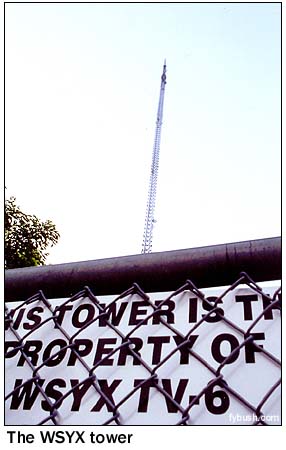 We'll
look at downtown Columbus in our second installment, next week.
Right now, we head south instead, down I-71 along the west side
of the Scioto River into a rundown area south of downtown. That's
where we pass the tower that's home to WRFD (880), the big (23
kW) daytimer that blankets most of Ohio with Salem's religious
programming, and to what was then WFII (1230). 1230's heritage
callsign was WCOL (it traces its history all the way back to
1922), and for most of the sixties and seventies it was the station
for top 40 radio in Columbus. Just last year, Clear Channel resurrected
the WCOL calls (it had been talk radio WZNW in the interim) and
installed its "Real Oldies" format on 1230, complete
with some of the historic jingles.
We'll
look at downtown Columbus in our second installment, next week.
Right now, we head south instead, down I-71 along the west side
of the Scioto River into a rundown area south of downtown. That's
where we pass the tower that's home to WRFD (880), the big (23
kW) daytimer that blankets most of Ohio with Salem's religious
programming, and to what was then WFII (1230). 1230's heritage
callsign was WCOL (it traces its history all the way back to
1922), and for most of the sixties and seventies it was the station
for top 40 radio in Columbus. Just last year, Clear Channel resurrected
the WCOL calls (it had been talk radio WZNW in the interim) and
installed its "Real Oldies" format on 1230, complete
with some of the historic jingles.
Just south of there, on Stimmel Road, is the current WSYX (Channel 6) transmitter site, which replaced the old Dodridge Street site in the early nineties. Since our 2000 visit, this tower has sprouted a two-prong candelabra on top to accommodate not only WSYX and WSYX-DT (Channel 13) but also WTTE (Channel 28) and WTTE-DT (Channel 36), which moved here from the WOSU-TV tower northeast of Columbus. (We'll see that next week.) Speaking of WOSU, this tower is home to WOSU-FM (89.7), as well as contemporary Christian WUFM (88.7) - just as at Dodridge, keeping the channel 6 facility at the same site as those low-dial FM stations eliminates potential interference to both signals.
By this point in our trip, it was getting very close to sunset, making our next stops more appropriate than it might at first seem. About four miles south of channel 6, near the spot where I-71 crosses the I-270 loop (and near where that sniper's been terrorizing motorists), we find the four towers of WMNI (920), North American Broadcasting's standards station (in AM stereo, no less), with 1000 watts by day and 500 watts by night in a tight directional pattern, fitting for a station that didn't sign on until 1958. That fifth tower, off to the right, was where WMNI-FM (99.7) used to be; it's now modern rock "Blitz" WBZX and uses the WBNS-TV tower. (The FM actually started out side-mounted on one of the AM towers and ran a grandfathered 89 kW before dropping down to the usual 50 kW when the taller tower went up. We'll see a much more powerful grandfathered facility next week when we circle back 'round to downtown Columbus...)
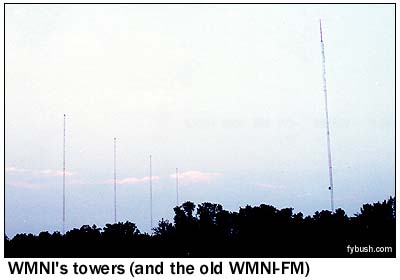
|
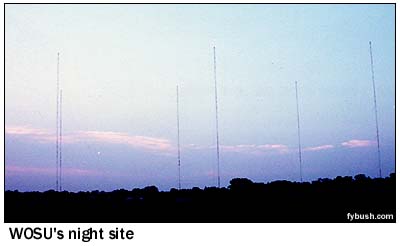
|
And from there, we made it to one more site before dark - but we'll get there next week!
Still haven't ordered? It's not too late - Tower Site Calendar 2004 is STILL AVAILABLE! All orders placed by Tuesday, February 17 have now been shipped - and if you haven't yet ordered, what are you waiting for? Click here for ordering information!
- Previous Site of the Week: Cleveland's Parma/Brecksville/Seven Hills Tower Farm
- Next Week: Columbus, Ohio, part II
- Site of the Week INDEX!
- How can you help support Site of the Week? Click here!
- Submit your suggestions for a future Site of the Week!
